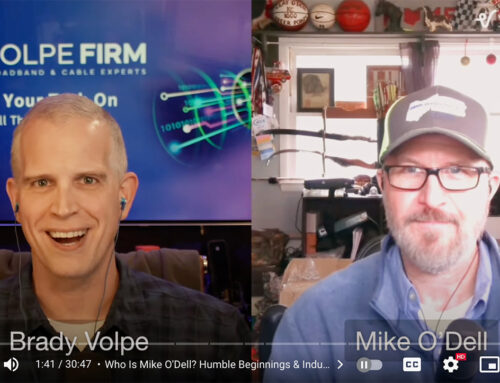What’s Next for DOCSIS 3.1 Modulation Options and Impacts
DOCSIS 3.1 modulation – Many wonder how today’s networks will support high order modulations such as 4096-QAM. There are two technologies in the DOCSIS 3.1 standard that will enable this without requiring changes to existing outside plant. The first is Orthogonal Frequency Division Multiplexing (OFDM). This is a complex word for taking many small QAM channels, like 25 kHz instead of 6 MHz, and placing them very close together. OFDM also has dynamic properties. If you have a block of 960 QAM channels, where each QAM channel is only 25 kHz wide, then the OFDM channel would occupy 24 MHz of bandwidth. In the ideal world all 960 QAM channels would be running at 4096-QAM. However in the real world it is expected that RF impairments will cause some of the QAM channels to drop to lower order modulations such as 1024-QAM or even 256-QAM. The good news is that each QAM channel can operate independently and transmit at the modulation it is capable of transmitting.
A second technology in the DOCSIS 3.1 standard is called Low-density parity-check (LDPC). This replaces the older Reed-Solomon forward error correction with a much more advanced error correction. LDPC is an advanced error-correction algorithm and models have shown that by using LDPC 4096-QAM will operate just like 256-QAM under the same impairment conditions. This is very good news for any technician with concerns about troubleshooting a plant with 4096-QAM. Once LDPC is in place, 4096- QAM in OFDM will be just like 256-QAM without OFDM!
SECTION 4
High SE Modulation Options and Their Pluses and Minuses
Of the generic modulation systems (m-VSB, m-QAM, m-PSK) m-PSK, where “m” is the integer number (usually even integer) of waveforms transmitted within the symbol (signaling) interval (Proakis, 1995), requires higher transmission power (which may exacerbate channel planning problems) and is therefore not preferred or considered for this discussion. QAM and VSB modulation systems have similar power requirements and noise performance.These modulation systems can be applied to either a single carrier (SC) modulated at a high data rate or to a large number of carriers modulated at relatively low rates – the multi-carrier approach.In both cases, the research work builds on experience gained in other fields. Experience with single carrier QAM and QPSK systems has come from applications in the fields of terrestrial microwave and satellite transmission. Experience with multi-carrier systems has come from high frequency modems designed for military and telephone applications, the digital audio broadcasting (DAB), and digital terrestrial broadcast – television (DVB-T) systems in Europe, among others.Today’s HFC and fiber-to-the-curb (FTTC) based plants employ signal modulation using single carrier (SC) methods. Table 1 compares advanced SC modulation technique capabilities with respect to spectral efficiency, minimum signal-to-noise ratio (SNR) to maintain 10-6 minimum bit error ratio (BER), and worst case peak-to-average power ratio (PAPR). Table 1 reveals that of the available SC modulation techniques, only 4096-QAM and 65536-QAM (“64k-QAM”) offers the SE required to meet DOCSIS 3.1/NG data rate requirements stated below (for 10+ Gbps downstream and 1+ Gbps upstream which equates to a SE requirement > 10 b/s/Hz with a BER of ≤10-6).Table 2 compares the plant SNR required to produce various BERs by SC modulation type.
-

Single Carrier (SC) Modulation Performance Comparison

Digitally Modulated Carrier Minimum CNR versus BER, (Hranac, 2005)
The following is an excerpt from a presentation called “DOCSIS® 3.1 Project: Key Objectives and Direction” given October 18, 2012 during SCTE Cable-Tec Expo 2012 and describes DOCSIS® 3.1/NG objectives (emphasis added by this author) (Schmitt, 2012):
-

Excerpt from “DOCSIS® 3.1 Project: Key Objectives and Direction” given October 18, 2012 during SCTE Cable-Tec Expo 2012 describing DOCSIS 3.1/NG objectives (Schmitt, 2012)

Basic Elements of 2nd Generation DVB Systems, an excerpt from “Current Status Of DVB-C2 – What The New Technology May Bring”, Sep2009, Dr. Dirk Jaeger, ReDeSign
Figure 8 shows how second generation European Union (EU) Digital Video Broadcast (DVB) standards DVB-S2, DVB-T2, and DVB-C2 rely on COFDM using LDPC and BCH error coding in a two layer error coding approach (LDPC for inner layer and BCH for outer layer error coding). BCH error coding form a class of cyclic codes that are constructed using finite fields. The acronym BCH comprises the initials of its inventors’ names Raj Bose , D. K. Ray-Chaudhuri, and Alexis Hocquenghem.
COFDM Overview
Why COFDM and why now?
First, many have and will continue to refer to the multi-carrier modulation technique as “OFDM” (orthogonal frequency division multiplex). In relation to any proposed use within a DOCSIS 3.1/NG enabled system the proper term is COFDM (coded orthogonal frequency division multiplex), not OFDM. The special performance of OFDM with respect to operation in conditions with multipath and interference is only achieved through careful choice of parameters plus attention to detail in the way forward error correction (FEC) is applied. The “C” in COFDM means the effective use of error coding, interleaving, and channel-state-information (CSI), without which OFDM is a wholly unacceptable means to achieve stated DOCSIS 3.1/NG objectives for improved data rate performance and lower cost per bit delivered.
Now to the why COFDM and why now question and some possible answers. Figure 9 shows how a single COFDM downstream physical layer (PHY) channel is formed by multiple sub carriers of differing modulation types, such as 256-QAM, 1024-QAM, and 4096-QAM. These multiple relatively narrow in frequency sub-carriers are transmitted together in a block with each sub-carrier individually adjustable.
-

COFDM Multi-Carrier Technique Illustrated with Sub-Carriers
Because each sub-carrier is narrow in frequency, a DOCSIS 3.1/NG plant enabled with COFDM can adjust to channel conditions and by-screen subscriber demand with kHz resolution. Operation at the former “band edge” is now possible, effectively freeing up between ten (10) and 16% of the presently underutilized downstream bandwidth (ten percent for digital channel filtering at the band edge by downstream channel and 16% for analog channel underutilization at the band edge). Effective use of COFDM means that HFC and FTTP (fiber-to-the-premises) plant is no longer restricted to six (6) or eight (8) MHz channels. Channel bandwidth can be assigned to match exact real-time subscriber demand or channel impairment conditions or both.
COFDM also offers a path to lower cost per delivered bit. How? Let’s list the ways below. COFDM:
- scales to large bandwidths (BWs) (>100s of MHz) more cost effectively than bonding many single carrier QAM channels
- permits easier channel synthesis
- is less complex at the MAC (medium access channel) layer
- allows additional capacity from the existing plant as described above
- allows incremental capacity additions as needed based on spectrum availability without newcable modem (CM) or CMTS/CCAP deployments
- is a widely adopted technology that may offer US cable operators better economies of scalefrom alignment with other COFDM based RF standards
- may allow US based cable industry to attract new chipset and system suppliers to our market
Unlocking the Magic of COFDM
By Brady Volpe and Conrad L. Young
As seen in CED December 2013 and available in our white papers
Previous events can be seen under the blog.
- If you are watching this on youtube please hit the subscribe button!
- Let us know what you think and remember to share!
- You can find slides at the bottom of the page and some on slideshare.
- Find out about events or articles by following us on Twitter, LinkedIn or Facebook too.
- We have stuff. Interested in buying some clothes with cable stuff. Click here
Also available on iTunes, Google Podcasts, Spotify, vurbl see podcasts “get your tech on”.





Leave a Reply